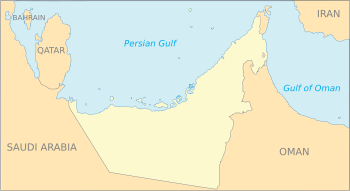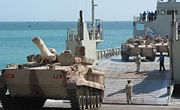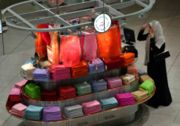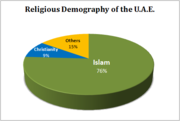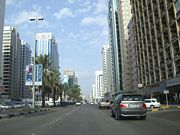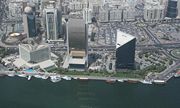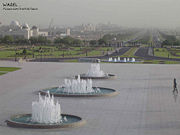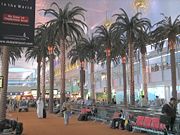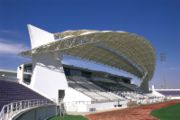United Arab Emirates
2008/9 Schools Wikipedia Selection. Related subjects: Middle Eastern Countries
| دولة الإمارات العربية المتحدة Dowlat Al-Imārāt al-‘Arabīya al-Muttaḥida United Arab Emirates
|
||||||
|---|---|---|---|---|---|---|
|
||||||
| Motto: "God, Nation, President" | ||||||
| Anthem: Ishy Bilady |
||||||
|
|
||||||
| Capital | Abu Dhabi |
|||||
| Largest city | Dubai | |||||
| Official languages | Arabic | |||||
| Demonym | Emirati | |||||
| Government | Federal constitutional monarchy | |||||
| - | President | Khalifa bin Zayed Al Nahyan | ||||
| - | Prime Minister | Mohammed bin Rashid Al Maktoum | ||||
| Establishment | December 2, 1971 | |||||
| Area | ||||||
| - | Total | 83,600 km² ( 116th) 32,278 sq mi |
||||
| - | Water (%) | negligible | ||||
| Population | ||||||
| - | 2007 estimate | 4,621,399 ( 119th) | ||||
| - | 2006 census | 4,588,697 | ||||
| - | Density | 64/km² ( 150rd) 139/sq mi |
||||
| GDP ( PPP) | 2007 estimate | |||||
| - | Total | $159.3 billion ( 54th) | ||||
| - | Per capita | $55,200 (CIA) ( 5th) | ||||
| GDP (nominal) | 2007 estimate | |||||
| - | Total | $192 billion ( 38th) | ||||
| - | Per capita | $42,934 ( 16th) | ||||
| HDI (2007) | ▲ 0.868 (high) ( 39th) | |||||
| Currency | UAE dirham ( AED) |
|||||
| Time zone | GMT+4 ( UTC+4) | |||||
| - | Summer ( DST) | not observed ( UTC+4) | ||||
| Internet TLD | .ae | |||||
| Calling code | +971 | |||||
The United Arab Emirates (UAE) (Arabic: دولة الإمارات العربية المتحدة, transliteration: Dowlat Al-Imārāt al-‘Arabīyah al-Muttaḥidah) is a Middle Eastern federation of seven states situated in the southeast of the Arabian Peninsula in Southwest Asia on the Persian Gulf, bordering Oman and Saudi Arabia. The seven states, termed emirates, are Abu Dhabi, Ajman, Dubai, Fujairah, Ras al-Khaimah, Sharjah, and Umm al-Quwain.
The UAE, rich in oil and natural gas, has become highly prosperous after gaining foreign direct investment funding in the 1970s. The country has a relatively high Human Development Index for the Asian continent and ranked 39th globally.
Before 1971, the UAE were known as the Trucial States or Trucial Oman, in reference to a nineteenth-century truce between Britain and several Arab Sheikhs. The name Pirate Coast was also used in reference to the area's emirates in the 18th to early 20th century.
History
The United Arab Emirates was formed from tribally organized Arabian Peninsula sheikhdoms along the southern coast of the Persian Gulf and the northwestern coast of the Gulf of Oman. The area became Islamic in the 7th century.
Later, portions of the nation came under the direct influence of the Ottoman Empire during the 16th century. Thereafter the region was known as the Pirate Coast, as raiders based there harassed the shipping industry despite both European and Arab navies patrolling the area from the 17th century into the 19th century. British expeditions to protect the Indian trade from raiders at Ras al-Khaimah led to campaigns against that headquarters and other harbors along the coast in 1819. The next year, a peace treaty was signed to which all the sheikhs of the coast adhered. Raids continued intermittently until 1835, when the sheikhs agreed not to engage in hostilities at sea. In 1853, they signed a treaty with the United Kingdom, under which the sheikhs (the "Trucial Sheikhdoms") agreed to a "perpetual maritime truce." It was enforced by the United Kingdom, and disputes among sheikhs were referred to the British for settlement.
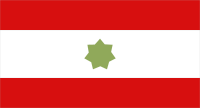
Primarily in reaction to the ambitions of other European countries, the United Kingdom and the Trucial Sheikhdoms established closer bonds in an 1892 treaty, similar to treaties entered into by the UK with other Persian Gulf principalities. The sheikhs agreed not to dispose of any territory except to the United Kingdom and not to enter into relationships with any foreign government other than the United Kingdom without its consent. In return, the British promised to protect the Trucial Coast from all aggression by sea and to help in case of land attack.
In 1955, the United Kingdom sided with Abu Dhabi in the latter's dispute with Oman over the Buraimi Oasis and other territory to the south. A 1974 agreement between Abu Dhabi and Saudi Arabia would have settled the Abu Dhabi-Saudi border dispute; however, the agreement has yet to be ratified by the UAE Government and is not recognized by the Saudi Government. The border with Oman also remains officially unsettled, but the two governments agreed to delineate the border in May 1999.
In the early 1960s Dubai was ahead of all the other states even though oil was not yet discovered in its territories. Abu Dhabi was behind until His Highness Shaikh Zayed bin Sultan Al Nahyan became ruler of Abu Dhabi in 1967, and instated Dr. Mana Alotaiba as Minister of Petroleum, who used his extensive knowledge about economics to build up the petroleum industry. Dr. Mana Alotaiba was also elected as president of OPEC a record of six times.
The British had earlier started a development office that helped in some small developments in the Emirates. The sheikhs of the Emirates decided then to form a council to coordinate matters between them and took over the development office. They formed the Trucial States Council, and appointed Adi Bitar, Sheikh Rashid bin Saeed Al Maktoum's Legal Advisor, as Secretary General and Legal Advisor to the Council. The Council was terminated once the United Arab Emirates was formed.
In 1968, the UK announced its decision, reaffirmed in March 1971, to end the treaty relationships with the seven Trucial Sheikhdoms which had been, together with Bahrain and Qatar, under British protection. The nine attempted to form a union of Arab Emirates, but by mid-1971 they were unable to agree on terms of union, even though the termination date of the British treaty relationship was the end of 1971.
Bahrain became independent in August and Qatar in September 1971. When the British-Trucial Shaikhdoms treaty expired on December 1, 1971, they became fully independent.
The rulers of Abu Dhabi and Dubai decided to form a union between their two Emirates independently, prepare a constitution, then call the Rulers of the other five emirates to a meeting and offer them to join. It was also agreed between both of them that Adi Bitar write the constitution and have it ready by 2 December 1971.
On December 2, 1971, at the Dubai Guesthouse Palace four other Emirates agreed to join and enter into a union of six Emirates called the United Arab Emirates. Ras al-Khaimah joined later, in early 1972.
The UAE sent forces into Kuwait during the 1990–91 Gulf War.
The UAE supports military operations from the United States and other Coalition nations that are engaged in the invasions of Iraq (2003) and Afghanistan (2002) as well as Operations supporting the Global War on Terrorism for the Horn of Africa at the al-Dhafra Air Base located outside of Abu Dhabi. The al-Dhafra Air Base also supported American and Allied Operations during the 1991 Persian Gulf War and Operation Northern Watch.
On November 2, 2004, the UAE's first president, Sheikh Zayed bin Sultan Al Nahyan, died. His eldest son, Khalifa bin Zayed Al Nahyan, succeeded him as ruler of Abu Dhabi. In accordance with the Constitution, the UAE's Supreme Council of Rulers elected Khalifa as president. Mohammad bin Zayed Al Nahyan succeeded Khalifa as Crown Prince of Abu Dhabi.
Emirates
The United Arab Emirates is a federation which consists of seven emirates. The largest emirate is Abu Dhabi which contains the nation's capital city Abu Dhabi. Five emirates have one or more exclaves, in addition to the main territory. The seven emirates:
- Abu Dhabi
- Ajman: 1 exclave
- Dubai: 1 exclave
- Fujairah: 2 exclaves
- Ras al-Khaimah: 1 exclave
- Sharjah: 3 exclaves
- Umm al-Quwain
There are two areas under joint control. One is jointly controlled by Oman and Ajman, the other by Fujairah and Sharjah.
There is an Omani enclave surrounded by UAE territory, known as Wadi Madha. It is located halfway between the Musandam peninsula and the rest of Oman, on the Dubai- Hatta road in the Emirate of Sharjah. It covers approximately 75 square kilometres (29 sq mi) and the boundary was settled in 1589. The north-east corner of Madha is closest to the Khor Fakkan- Fujairah road, barely 10 metres (33 ft) away. Within the enclave is a UAE exclave called Nahwa, also belonging to the Emirate of Sharjah. It is about 8 kilometres (5 mi) on a dirt track west of the town of New Madha. It consists of about forty houses with its own clinic and telephone exchange.
Politics
The Presidency and Premiership of the United Arab Emirates is de facto hereditary to the Al Nahyan clan of Abu Dhabi and the Al Maktoum clan of Dubai. The Supreme Council, consisting of the rulers of the seven emirates, also elects the Council of Ministers, while an appointed forty-member Federal National Council, drawn from all the emirates, reviews proposed laws. There is a federal court system; all emirates except Dubai and Ras al-Khaimah have joined the federal system; all emirates have both secular and Islamic law for civil, criminal, and high courts. Sheikh Zayed bin Sultan Al Nahyan was the union's president from the nation's founding until his death on 2 November 2004. The Federal Supreme Council elected his son, Khalifa bin Zayed Al Nahyan, president the next day. Crown Prince Mohammed bin Zayed Al Nahyan is the heir apparent.
Demographics
The UAE population has an unnatural sex distribution consisting of more than twice the number of males than females. The 15-65 age group has a male(s)/female sex ratio of 2.743. UAE's gender imbalance is the highest among any nation in the world followed by Qatar, Kuwait, Bahrain, Oman, and Saudi Arabia - all of which together comprise the Gulf Cooperation Council (GCC). The GCC states are also what most South and Southeast Asians refer to as the Persian Gulf especially in context of emigration.
UAE has one of the most diverse populations in the Middle East. 19 % of the population is Emirati, and 23 % is other Arabs and Iranians . An estimated 85 percent of the population is comprised of non-citizens, one of the world's highest percentages of foreign-born in any nation. In addition, since the mid-1980s, people from all across South Asia have settled in the UAE. The high living standards and economic opportunities in the UAE are better than almost anywhere else in the Middle East and South Asia. This makes the nation an attractive destination for Indians, Filipinos, Pakistanis, and Bangladeshis along with a few thousand Sri Lankans. In 2006, there were approximately 2.15 million Indian nationals, Philippines Nationals— OFW, Bangladeshi nationals, and Pakistani nationals in the UAE, making them the largest expatriate community in the oil-rich nation. Persons from over twenty Arab nationalities, including thousands of Palestinians who came as either political refugees or migrant workers, also live in the United Arab Emirates. There is also a sizable number of Emiratis from other Arab League nations who have come before the formation of the Emirates such as Egyptians, Somalis, Sudanese and other Gulf Arab states, who have adopted the native culture and customs. Further, Somali immigration also continued in the 1990s as a result of the Somali civil war.
There are also residents from other parts of the Middle East, Baluchistan region of Pakistan, Iran and Afghanistan, Africa, Europe, Post-Soviet states, and North America. The UAE has attracted a small number of very affluent expatriates (Americans, British, Canadians, Japanese, Chinese and Australians) from developed countries who are attracted to a very warm climate, scenic views (beaches, golf courses, man-made islands and lucrative housing tracts in Abu Dhabi and Dubai), the nation's comparably low cost of living (but in 2006, thousands of real estate properties are valued over millions of dollars) and tax-free incentives for their business or residency in the UAE. They make up under 5 percent of the UAE population; mainly English-speaking. Expatriates adhere to the law and customs of the UAE, their adopted country.
The most populated city is Dubai, with approximately 1.6 million people. Other major cities include Abu Dhabi, Al Ain, Sharjah, and Fujairah. About 88% of the population of the United Arab Emirates is urban. The remaining inhabitants live in tiny towns scattered throughout the country or in one of the many desert oilfield camps in the nation.
Culture and religion
- See also: Islam in the United Arab Emirates, Roman Catholicism in the United Arab Emirates, Bahá'í Faith in the United Arab Emirates, Music of the United Arab Emirates, Cinema of the United Arab Emirates, UAE Public Library and Cultural Centre, and Yowla
Rooted in Islamic culture, the UAE has strong ties with the rest of the Arab and Islamic world. The government is committed to preserving traditional forms of art and culture, primarily through the Abu Dhabi Cultural Foundation. The first known manuscript produced in the UAE was Al jawaher wal la'li, a text which discusses the emirates of the nation.
Nearly all citizens are Muslims, approximately 85 percent of whom are Sunni and the remaining 15 percent are Shi'a. According to official ministry documents, 76 percent of the total population is Muslim, 9% is Christian, and 15 percent is other. Other unnofficial sources claim that 15 percent is Hindu, 5 percent is Buddhist, and the remaining 5 percent is other (mainly including Parsi, Bahá'í, and Sikh).
Dubai is the only emirate of the UAE with both a Hindu Temple and a Sikh Gurdwara. Christian church buildings are also present in the country. There are a variety of Asian-influenced schools, restaurants and cultural centers.
Economy
The United Arab Emirates is one of the most developed in the world, based on various socioeconomic indicators such as GDP per capita, energy consumption per capita, and the Human Development Index.
The GDP per capita is currently the 16th in the world and 3rd in the Middle East after Qatar and Kuwait as measured by the CIA World Factbook, or the 17th in the world as measured by the International Monetary Fund; while at $168 billion in 2006, with a small population of 4 million, the GDP of the UAE ranks second in the CCASG (after Saudi Arabia), third in the Middle East — North Africa ( MENA) region (after Saudi Arabia and Iran), and 38th in the world (ahead of Malaysia).
There are various deviating estimates regarding the actual growth rate of the nation’s GDP. However, all available statistics indicate that the UAE currently has one of the fastest growing economies in the world. According to a recent report by the Ministry of Finance and Industry, real GDP rose by 35 percent in 2006 to $175 billion, compared with $130 billion in 2005. These figures would suggest that the UAE had the fastest growing real GDP in the world, between 2005 and 2006.
Although the United Arab Emirates is becoming less dependent on natural resources as a source of revenue, petroleum and natural gas exports still play an important role in the economy, especially in Abu Dhabi. A massive construction boom, an expanding manufacturing base, and a thriving services sector are helping the UAE diversify its economy. Nationwide, there is currently $350 billion worth of active construction projects. Such projects include the Burj Dubai, which is slated to become the world's tallest building, Dubai World Central International Airport which, when completed, will be the most expensive airport ever built, and the three Palm Islands, the largest artificial islands in the world. Other projects include the Dubai Mall which will become the world's largest shopping mall when completed, and a man-made archipelago called The World which seeks to increase Dubai's rapidly growing tourism industry. Also in the entertainment sector is the construction of Dubailand, which is expected to be twice the size of Disney World, and of Dubai Sports City which will not only provide homes for local sports teams but may be part of future Olympic bids.
The currency of the United Arab Emirates is the Emirati Dirham, exchanging at a rate of about 3.67 per US dollar.
Education
The education system up to the secondary level is monitored by the Ministry of Education. It consists of primary schools, middle schools and secondary schools. The public schools are government-funded and the curriculum is created to match the United Arab Emirates development's goals and values. The medium of instruction in the public school is Arabic with emphasis on English as a second language. There are also many private schools which are internationally accredited. Public schools in the country are free for citizens of the UAE, while the fees for private schools vary.
The higher education system is monitored by the Ministry of Higher Education to serve and protect children's education. The Ministry also is responsible for admitting students to its undergraduate institutions, including the five largest centers of higher education: United Arab Emirates University, Zayed University, Gulf Medical College, University of Sharjah and Higher Colleges of Technology. There are also many other private universities and colleges in the country, including the American University of Sharjah, Institute of Management Technology Dubai, S.P Jain Centre of Management in Dubai, Al Ain University of Science and Technology, the American University of Dubai, Abu Dhabi University and Ras Al Khamiah University for medical and health sciences. Finally, other universities based in foreign countries have established campuses in the United Arab Emirates. For instance, there is a Paris-Sorbonne campus in Abu Dhabi.
The UAE has shown a strong recent interest in improving education and research. Recent enterprises include the establishment of the CERT Research Centers and the Masdar Institute of Science and Technology.
Human rights
Although the UAE government has made some advances in the protection of human rights, the U.S. Department of State notes in its annual report on human rights practices that numerous fundamentalist practices and policies exist to the contrary.
Guest workers are brought in from South Asia, and a common objection is that they are grossly underpaid as their passports are held by their employers. There have been many reports of unskilled workers getting underpaid, and complaints of segregation abound.
The form of Sharia exercised prohibits ' sodomy', effectually outlawing any homosexual relationships.
The UAE also does not allow individuals past retirement age to stay within the country without a job. Upon retirement, residents must return to their country of origin.
Discrimination in the workplace is common, prospective employers will specify religion, nationality (and even regional origin in some cases) and also specify the sex of required candidates within job advertisements. It is very common to have different pay scales depending on nationality and sex. Policies are in place in certain instances where state employers are required to fill in vacancies with UAE nationals, a process called Emiratisation. This seems to be in line with similar policies by the EU, for example, where employers, public and private, are encouraged to fill in job vacancies with EU nationals.
Transportation
Dubai has a public transport system called the Roads and Transport Authority (RTA). This authority is responsible for the bus network currently in operation. Recently, the RTA purchased 300 buses from Germany's MAN AG in an effort to reduce the city's growing traffic problem. RTA is also developing the Dubai Metro system. The first line (Red Line) is expected to complete by September 2009. The yellow lines, currently in development will go through the man-made Palm Islands.
Lately, Emirate of Dubai has created new electronic toll collection system in July 2007, which emphasizes the system’s congestion management objectives as well as the choice of technology for the toll system. The new system, which is called Salik (meaning clear and smooth in Arabic) utilizes the latest technology to achieve free flow operation with no toll booths, no toll collectors, and no impact to traffic flow, allowing vehicles to move freely through the toll point at highway speeds. Each time one passes through a Salik toll point, the toll of AED 4 (1.09 USD) will be deducted from his or her prepaid toll account using advanced Radio Frequency Identification (RFID) technology. The new system was introduced and executed by Roads and Transport Authority of Dubai.
Airline history
The national airline of Abu Dhabi was formerly Gulf Air, operated jointly with Bahrain and Oman. On September 13, 2005, Abu Dhabi announced that it was withdrawing from Gulf Air to concentrate on Etihad Airways, designated as the new national carrier of the UAE, established in November 2003.
In 1985, Dubai established its airline Emirates, which, as of 2007, is one of the fastest growing airlines in the world.
Air Arabia, a leading discount airline in the Persian Gulf region, is based in the Emirate of Sharjah.
RAK Airways is the fourth national airways of the United Arab Emirates, was established in February 2006, is based in the Emirate of Ras Al Khaimah.
Ports and harbours
The United Arab Emirates has several major ports, including one of the world's largest, Jebel Ali Port. Other important ports in the UAE include Port Zayed, Khalifa Port, Port Rashid, Port Khalid, Hamriyah Port, Port of Ajman, Saqr Port, Um Al Quwain, Khor Fhakan and Fujairah Port.
Sports
New sports are becoming popular alongside traditional camel racing. Examples of these new sports include golf, with two European Tour events in the country (the Dubai Desert Classic and the Abu Dhabi Golf Championship) and the world's richest horse race, the Dubai World Cup, held annually in March.
Aside from the international circuit events, the UAE has a healthy indigenous sporting environment with the local community participating in a wide variety of clubs and establishments. The seven emirates regularly compete in national leagues and cups in a multiplicity of sports that are controlled by specialized governing bodies.
The country itself is a prime location for sporting events. The high quality sporting venues (both indoor and outdoor), in addition to the climate, ensure the continuation of activities throughout the winter season. Construction of Dubai Sports City is underway to take advantage of these benefits, and to establish the country as a hub for sports throughout the world.
Football (soccer)
The UAE has a huge interest in football. The United Arab Emirates Football Association was first established in 1971 and since then has dedicated its time and effort to promoting the game, organising youth programmes and improving the abilities of not only its players, but of the officials and coaches involved with its regional teams. The U.A.E. football team qualified for the World Cup in 1990 - with Egypt it was the third consecutive World Cup with two Arab nations qualifying after Kuwait and Algeria in 1982 and Iraq and Algeria again in 1986.
The UAE National Team won the 2005 Kirin Cup, sharing the cup with Peru after a 1-0 victory over host country Japan.
The UAE team played a four-team friendly in Switzerland in July 2005, in which they beat both Qatar and Kuwait but lost 5–4 on penalties in the final against Egypt.
In 2003 the UAE was the host nation of the FIFA U-20 World Cup between November and December 2003.
In April, Dubai Holding agreed to provide the national team with Dh20 million (US$5.45 million) sponsorship money over the next four years. The fund will also go towards developing the sport.
The UAE also recently won the Gulf Cup soccer championship held in Abu Dhabi January 2007.
The UAE are currently ranked ninety-seventh in the world according to the FIFA World Rankings.
Tennis
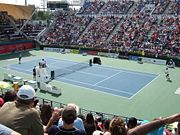
The Dubai Duty Free Tennis Championships (part of the ATP International Series Gold at the Aviation Club, Dubai) was bigger than ever in 2000 with no less than six of the top-seeded women’s players taking centre court, a first time appearance by tennis’ golden boy, Andre Agassi, and the return of the celebrated Roger Federer, who was seeking his third title crown, resulting in some dramatic court action. In an unprecedented move, Dubai Duty Free, organisers of the championship, decided to switch the men’s tournament to the first week of the competition so that it ran from 21 to 27 February and the women’s was played from 28 February to 5 March.
Cricket
Cricket is one of the most popular sports in the UAE. Sharjah Cricket Association Stadium in Sharjah has hosted 5 international Test matches so far. Sheikh Zayed Stadium and Al Jazira Mohammed Bin Zayed Stadium in Abu Dhabi also hosts international cricket. Dubai also has two cricket stadiums (Dubai Cricket Ground No.1 and No.2) with a third, 'S3' currently under construction as part of Dubai Sports City. Dubai is also home to the International Cricket Council.
The United Arab Emirates national cricket team qualified for the 1996 Cricket World Cup and narrowly missed out on qualification for the 2007 Cricket World Cup.
Camel racing
The inhabitants of the Persian Gulf states have enjoyed camel racing for many years as it is considered a traditional sport. Formalizing camel racing was one way of maintaining its central role in UAE life. In the past, UAE had a reputation for exploiting South Asian children as jockeys. However, Robot jockeys are now used after strict government regulations were passed prohibiting underage jockeys from racing.
The UAE now has no fewer than 15 race tracks across the seven emirates. Nad Al Sheba Racecourse, 10 kilometers outside of Dubai, Al Wathba, 30 kilometers south-east of Abu Dhabi, and Al Ain track, which is 20 kilometers west of Al Ain, are all large, well-equipped camel tracks with high-tech facilities. Two smaller tracks are located in Sharjah, one in Ra’s al-Khaimah and one in Umm al-Qaiwain. Others are spread throughout the desert areas.
F1
In February 2007 it was announced that Bernie Eccelstone had signed a seven year deal with Abu Dhabi, to host a Formula 1 race there from the 2009 season. The 5.6 km circuit is to be set on Yas Island and it will include street and marina sections similar to Monaco's course.
Rugby Sevens
U.A.E. hosts Dubai Sevens round of the IRB Sevens World Series at Dubai Exiles Rugby Ground.
Falconry
The U.A.E. is well-known for its falconry as it is also considered a traditional sport. Many of UAE's rulers were enthusiasts in falconry as the nation imports falcons from all across the globe.
Holidays
| Date | English | Arabic | |
|---|---|---|---|
| 1 January | New Year's Day | رأس السنة الميلادية | |
| variable | Day of the Sacrifice | Eid ul-Adha | عيد الأضحى |
| variable | Islamic New Year | Ra's as-Sana al-Hijria | رأس السنة الهجرية |
| variable | The Night Journey | Al-Isra'a wal-Mi'raj | الإسراء والمعراج |
| 2 December | National Day | Al-Eid al-Watani | العيد الوطني |
| variable | End of Ramadan | Eid ul-Fitr | عيد الفطر |



